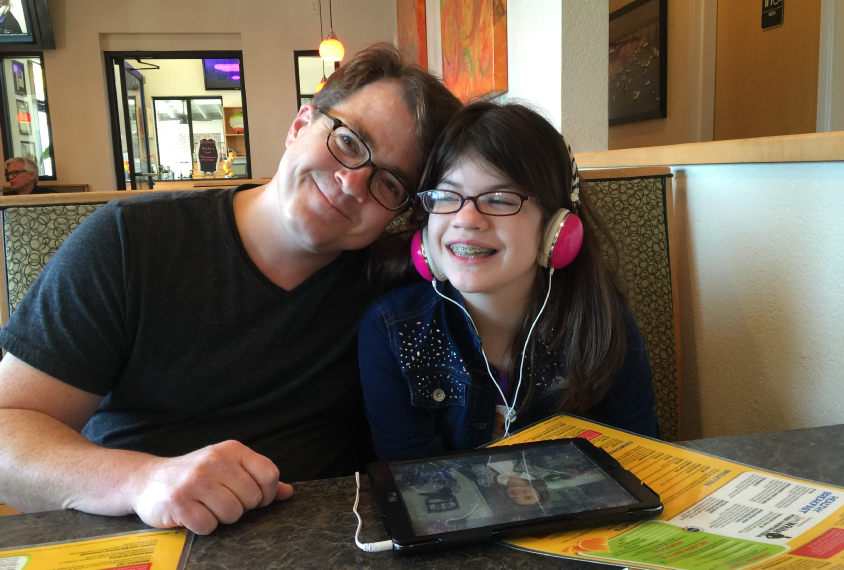
Annie Pelphrey
THIS ARTICLE IS MORE THAN FIVE YEARS OLD
This article is more than five years old. Autism research — and science in general — is constantly evolving, so older articles may contain information or theories that have been reevaluated since their original publication date.

My 12-year-old daughter Frances loves music, but our musical tastes do not align. How many times can I listen to the soundtrack from “The Descendants” before losing my mind? And why must it be played at ‘volume 10?’ (Because, Nigel, there is no 11.)
I find my daughter’s love of music and her singing at home somewhat perplexing, however. You see, my brilliant, beautiful daughter has autism. In most other contexts, a prominent feature of her autism is an extreme dislike of loud noises. That dislike becomes especially apparent in restaurants. Despite careful planning, earplugs and bribery, taking Frances to a restaurant often leads to an emotional meltdown and sometimes a dangerous attempt to flee.
Our family is not alone. Many of the families who come to the Autism and Neurodevelopmental Disorders Institute that I lead at George Washington University in Washington, D.C., report similar experiences.
Why are restaurants so problematic for our children? I am fortunate in that Frances can articulate what upsets her about restaurants. She says restaurants play music she doesn’t like “way too loud.” And restaurants are structured in a way that makes it difficult to escape the crowd when she feels anxious. When these two factors converge, Frances feels overwhelmed.
Frances’ observations led my colleagues and me to launch a brain imaging and treatment study of anxiety in adolescents with autism. Our approach is designed to help people with autism cope with noisy, chaotic environments. But I also hope that we can find ways to make environments such as restaurants more accessible to people with emotional as well as physical disabilities.
Sensory overload:
We began our work to better understand sensory sensitivity in autism about five years ago, when I was a professor at the Yale Child Study Center. We asked ourselves: Is there something about the way people like Frances integrate auditory and visual social information that makes going to a restaurant so distressing? We homed in on a long groove called the superior temporal sulcus (STS) that extends along the side of the brain.
The STS responds to social information delivered by way of sensory systems that process hearing, sound and probably touch1. If the sight and sound seem to line up — as they do when someone’s mouth moves in a way that matches the sounds they produce — neurons in the STS respond with an intensity greater than the sum of its responses to each sensory stimulus alone.
To the listener, this ‘super-additive response’ substantially boosts perceived loudness and facilitates understanding. It also underlies effective social interactions. (If sight and sound seem to conflict, as they might in a poorly dubbed movie, the resulting neural response is less than either one of the parts2.)
We are testing the hypothesis that sensory integration in the STS is atypical in people with autism. Using functional magnetic resonance imaging (fMRI) and electrophysiology, we are measuring brain responses to matched and mismatched audiovisual stimuli. Our preliminary findings reveal that, in individuals with autism, the STS generates super-additive responses to a much wider range of both types of stimuli than it does in typically developing children.
Imagine how you might experience loud, crowded restaurants if you struggled with integrating sound and vision. Blaring music, people walking and talking, voices on a television and the sounds of cooking food would assault your senses. Instead of inhibiting its reaction to unrelated stimuli, your brain would search for connections between them, generating amplified, super-additive responses to the cacophony. This amplification of neural activity might well drive you to tears.
Acting ‘brave:’
I am struck by how well children with autism cope with this sensory onslaught —especially because these children also have exaggerated emotional responses and poor emotional control3. In another study we conducted in 2014, my team compared brain mechanisms for cognitive reappraisal — a method of emotion regulation that involves thinking about something in a different way — in adolescents with and without autism4.
We asked each group of youths to reappraise disgusting images such as those of mucus hanging from a person’s nose and roadkill on a highway. They were instructed to reappraise the pictures by, for example, pretending the mucus was silly putty or that the roadkill was not real. Using fMRI, we found that typically developing adolescents show greater functional connectivity between the amygdala and a part of prefrontal cortex during this task than adolescents with autism do. These two brain regions make up a circuit responsible for experiencing and regulating emotion.
These findings provide a potential target for assessing the success of behavioral or other treatments. We are recruiting children and adolescents with autism for a study in which they would receive 16 weekly sessions of cognitive behavioral therapy (CBT) for anxiety or a comparison ‘treatment’ that includes education about anxiety and psychological support.
Before beginning therapy, the participants make a list of anxiety symptoms and feared situations (restaurants often top these lists). Then the adolescents learn how to cope with anxiety by thinking differently about their fears and, through a series of tailored exercises, acting ‘brave’ in situations that trigger anxiety. We hypothesize that the CBT will lessen their anxiety and enhance emotion regulation by increasing connectivity between the amygdala and the prefrontal cortex.
Dark designs:
Frances has benefited from CBT and other therapeutic approaches aimed at helping her to reframe frustrating and frightening experiences. Our family also adjusts to make dining out easier for Frances. We pick quiet, off-peak times; we bring earplugs or an iPod with ear buds for her; if the staff seems particularly friendly, we ask them to turn down the music.
Ideally, though, the concept of restaurant design would change, too. In college, I toyed with the idea of becoming an architect. Some of my favorite design courses focused on the intersection of psychology, perception and design. They taught students to create environments that controlled sound while enhancing other perceptual experiences and social interactions.
But there is a dark side to design in which architects use information about human psychology and neuroscience to manipulate buildings’ occupants. Loud music is a fantastic tool for this purpose. In a restaurant, loud music increases appetite and thirst while motivating people to eat quickly to escape the noise. Greater consumption and table turnover increase profits.
Dining rooms are also arranged with many small tables in close proximity, boosting both capacity for patrons and discomfort at once — again raising revenues. But these features are fundamentally at odds with the needs of our families.
Simple solutions:
So what can we do? The Americans with Disabilities Act (ADA) of 1990 imposes accessibility requirements on public accommodations. It states that no individual may be discriminated against on the basis of a disability. He or she must have access to the “full and equal enjoyment” of any place of “public accommodation.” Public accommodations include restaurants. One of the definitions of ‘discrimination’ under the ADA is a “failure to remove” architectural barriers in existing facilities.
As a result of the ADA, many restaurants and other public places have made innovative changes to make their spaces more welcoming for people with autism and their families. These include special ‘autism-friendly’ nights, dining rooms with lots of space between tables, low lights and soft music.
Still, visiting most ‘family-friendly’ restaurants is difficult for Frances. More often than not, at her request, I take my other children out to eat, and bring home her favorite meal in a to-go box. But meals are not the same without her, and I worry about the effects of this form of social exclusion on her.
For the sake of Frances and others like her, I would like to ask all restaurant proprietors to turn down the music and arrange the tables to provide more personal space. These two simple adjustments would make a big difference to families who struggle with autism. And I’ll bet you will not hear many, if any, calls from other patrons for a louder, more crowded dining experience.
Kevin Pelphrey is Carbonell Family Professor and Director of the Autism and Neurodevelopmental Disorders Institute in Washington, D.C.
By joining the discussion, you agree to our privacy policy.